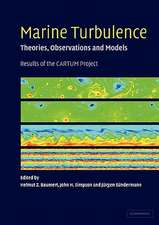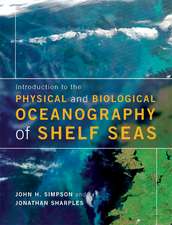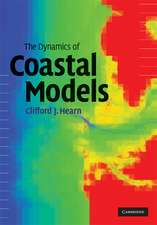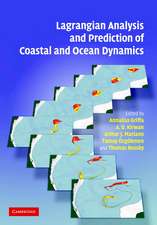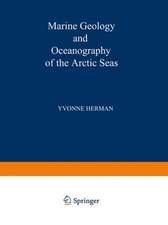Oceanic Circulation Models: Combining Data and Dynamics: Nato Science Series C:, cartea 284
Editat de D.L.T. Anderson, J. Willebranden Limba Engleză Paperback – 12 feb 2012
| Toate formatele și edițiile | Preț | Express |
|---|---|---|
| Paperback (1) | 407.39 lei 6-8 săpt. | |
| SPRINGER NETHERLANDS – 12 feb 2012 | 407.39 lei 6-8 săpt. | |
| Hardback (1) | 415.07 lei 6-8 săpt. | |
| SPRINGER NETHERLANDS – 31 aug 1989 | 415.07 lei 6-8 săpt. |
Din seria Nato Science Series C:
- 24%
 Preț: 797.66 lei
Preț: 797.66 lei - 18%
 Preț: 957.62 lei
Preț: 957.62 lei - 18%
 Preț: 957.13 lei
Preț: 957.13 lei - 18%
 Preț: 1227.52 lei
Preț: 1227.52 lei -
 Preț: 396.40 lei
Preț: 396.40 lei -
 Preț: 403.75 lei
Preț: 403.75 lei - 18%
 Preț: 1239.37 lei
Preț: 1239.37 lei - 18%
 Preț: 1236.51 lei
Preț: 1236.51 lei - 18%
 Preț: 1231.78 lei
Preț: 1231.78 lei - 18%
 Preț: 1229.10 lei
Preț: 1229.10 lei - 18%
 Preț: 1835.21 lei
Preț: 1835.21 lei - 24%
 Preț: 1076.36 lei
Preț: 1076.36 lei -
 Preț: 390.46 lei
Preț: 390.46 lei -
 Preț: 369.63 lei
Preț: 369.63 lei - 18%
 Preț: 1232.41 lei
Preț: 1232.41 lei -
 Preț: 394.51 lei
Preț: 394.51 lei - 18%
 Preț: 1226.24 lei
Preț: 1226.24 lei - 18%
 Preț: 1845.80 lei
Preț: 1845.80 lei -
 Preț: 399.88 lei
Preț: 399.88 lei -
 Preț: 384.28 lei
Preț: 384.28 lei -
 Preț: 390.88 lei
Preț: 390.88 lei -
 Preț: 381.19 lei
Preț: 381.19 lei - 18%
 Preț: 1848.64 lei
Preț: 1848.64 lei - 18%
 Preț: 951.14 lei
Preț: 951.14 lei - 18%
 Preț: 1230.35 lei
Preț: 1230.35 lei - 18%
 Preț: 1236.51 lei
Preț: 1236.51 lei -
 Preț: 401.03 lei
Preț: 401.03 lei -
 Preț: 406.25 lei
Preț: 406.25 lei - 18%
 Preț: 1230.84 lei
Preț: 1230.84 lei -
 Preț: 418.34 lei
Preț: 418.34 lei - 18%
 Preț: 1223.74 lei
Preț: 1223.74 lei
Preț: 407.39 lei
Nou
Puncte Express: 611
Preț estimativ în valută:
77.96€ • 81.60$ • 64.88£
77.96€ • 81.60$ • 64.88£
Carte tipărită la comandă
Livrare economică 31 martie-14 aprilie
Preluare comenzi: 021 569.72.76
Specificații
ISBN-13: 9789401069465
ISBN-10: 9401069468
Pagini: 632
Ilustrații: XXIII, 605 p.
Dimensiuni: 155 x 235 x 33 mm
Greutate: 0.87 kg
Ediția:Softcover reprint of the original 1st ed. 1989
Editura: SPRINGER NETHERLANDS
Colecția Springer
Seria Nato Science Series C:
Locul publicării:Dordrecht, Netherlands
ISBN-10: 9401069468
Pagini: 632
Ilustrații: XXIII, 605 p.
Dimensiuni: 155 x 235 x 33 mm
Greutate: 0.87 kg
Ediția:Softcover reprint of the original 1st ed. 1989
Editura: SPRINGER NETHERLANDS
Colecția Springer
Seria Nato Science Series C:
Locul publicării:Dordrecht, Netherlands
Public țintă
ResearchCuprins
Tracer Inverse Problems.- 1. Introduction.- 2. Interpolation and Map Making.- 3. Simple Estimation.- 4. Using Steady Tracers.- 5. Time Dependent Problems.- Appendix. Some Notes on the History of Inverse Methods in Ocean Circulation Problems.- A Geometrical Interpretation of Inverse Problems.- 1. The Overdetermined Case.- 2. The Underdetermined Case.- 3. The Singular Value Decomposition (SVD).- Determining Diffusivities from Hydrographic Data by Inverse Methods with Applications to the Circumpolar Current.- 1. Introduction to Ill-posed and Noisy Problems.- 2. The Physical Model.- 3. The Inverse Model.- 4. Examples: Circulation and mixing in the Southern Ocean.- Ocean Acoustic Tomography: a Primer.- 1. Introduction.- 2. Elementary Hydrodynamics and Acoustics.- 3. Ocean Sound Speed Distribution.- 4. Rays and Modes.- 5. Capsule Description of the Tomographic Method.- 6. A Simple Ray Example.- 7. Notes on Hardware Limitations and Observational Errors.- 8. Inversions.- 9. Some Results and Future Plans.- 10. Conclusions.- 11. Literature.- The Circulation in the Western North Atlantic Determined by a Nonlinear Inverse Method..- 1. Introduction.- 2. A Nonlinear Inverse Formalism.- 3. The Circulation in the Western North Atlantic.- Altimeter Data Assimilation into Ocean Circulation Models — Some Preliminary Results.- 1. Introduction.- 2. A Dynamic Initialization Scheme.- 3. Time and Space Dependence of the Observations.- 4. Geosat Assimilation in the Agulhas Retroflection Region.- 5. Discussion.- Assimilation of Data into Ocean Models.- 1. Introduction.- 2. Theory.- 3. Applications.- 4. Conclusions.- Driving of Non-linear Time-dependent Ocean Models by Observation of Transient Tracers — a Problem of Constrained Optimisation.- 1. Introduction.- 2. A Control Problem.- 3. AnElegant and Efficient Way to Calculate the Gradient of the Cost Function.- 4. The Ocean Model and its Adjoint.- 5. Results.- 6. Model Parameters as Control Variables.- 7. Sensitivity.- 8. Conclusions.- Assimilation of XBT Data Using a Variational Technique.- 1. Introduction.- 2. Implementation of Variational Assimilation Using Lagrange Multipliers.- 3. Results.- The Role of Real-Time Four-Dimensional Data Assimilation in the Quality Control, Interpretation, and Synthesis of Climate Data.- 1. Introduction.- 2. The Importance of Accurate Data Assimilation for NWP.- 3. The Analysis Module.- 4. Non-linear Normal Mode Initialization.- 5. The Forecast Model.- 6. Quality Control and Data Monitoring.- 7. The Value and Limitations of Global NWP Datasets for Climate Studies.- 8. Inversion and Quality Control of Remotely Sensed Data.- 9. Real-Time Integration and Synthesis of WCRP Observations.- to Chemical Tracers of the Ocean Circulation.- 1. Dimensional Analysis of a Tracer Conservation Equation.- 2. General Information on Tracers of Ocean Circulation.- 3. Surface Boundary Conditions.- 4. Mixing in the Deep Ocean.- 5. Conclusion.- On Oceanic Boundary Conditions for Tritium, on Tritiugenic 3He, and on the Tritium-3He Age Concept.- 1. Introduction.- 2. Tritium Ocean Surface Boundary Condition.- 3. Separation of Tritiugenic 3He.- 4. The Tritium-3He Age Concept.- 5. Tritium-3He Age Distributions on Isopycnal Surfaces in the Lower Northeast Atlantic Main Thermocline.- 6. Conclusions.- Ocean Carbon Models and Inverse Methods.- 1. Introduction.- 2. Diagnostic Equations.- 3. Parameterization of the Model: Methodological Issues for Inverse Methods.- 4. Some Preliminary Experiments.- Model of the Nutrient and Carbon Cycles in the North Atlantic. An Application of Linear Programming Methods.- 1. Introduction.- 2. The Model.- 3. Results for the ‘Inorganic’ Case.- 4. Results for the ‘Inorganic and Organic’ Case.- 5. Summary.- The Design of Numerical Models of the Ocean Circulation.- 1. Fundamentals of Model Design.- 2. Stability.- 3. Stability of Advective Schemes and Vertical Coordinates.- 4. The Application of Ocean General Circulation Models.- Instabilities and Multiple Steady States of the Thermohaline Circulation.- 1. Introduction.- 2. Box Models.- 3. 2-D Model.- 4. GFDL Model.- 5. Conclusions.- Subgridscale Representation.- 1. Introduction.- 2. Organization.- 3. Quasi-horizontal Stirring.- 4. Quasi-vertical Mixing.- 5. Benthic Boundary Processes.- Appendix A.- Appendix B.
Recenzii
`In summary, the editors have assembled a rather well integrated collection of lectures... The book should be warmly recommended to anyone, wishing to enter this burgeoning oceanographic discipline.'
Pageoph 135 (1) 1991
Pageoph 135 (1) 1991

